|
|
|
 |
|
|
|
|
|
|
|
|
|
North Street - East Side: No's 2-4
|
|
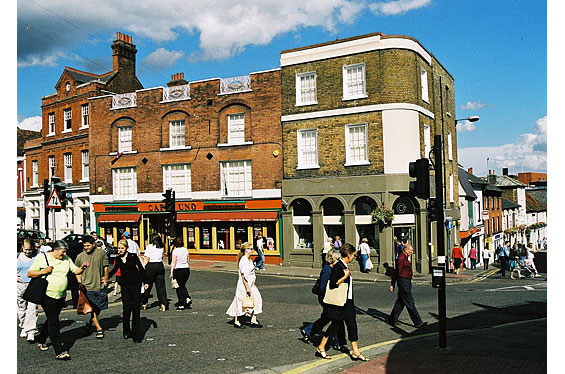
Up until 1999 this early 19th century building had been a clothing store named Barretts – the name established in the town since the late 1800s when Alfred Slapps Barrett entered into a partnership with Major William Holland JP and purchased a grocery store at No 18 North Street, formerly owned by Messrs Dodd & Burls.
Along with grocery items, Dodd & Burls had increased their retail trade by also selling men's and women's loose garments. Seeing no reason to change this rather diverse mix, Holland and Barrett continued to do the same and when in the early 1900s the chance came to expand their business by purchasing this property, they moved the clothing department to here.
The partnership ended in March 1915 with the death of William Holland JP, but Alfred Barrett continued to run both shops and eventually built the grocery business into a successful wholesale and retail outlet. For whatever reason though, he sold the business in the 1920s to Messrs Alfred Button & Sons. They wisely kept the familiar and popular name of Holland & Barrett above the door, but when they sold out to Bookers in the early 1970s the shop's name was changed to Budgens.
|
|
When Mr Barrett died in 1933 he stipulated in his will that the manager of his clothing store, Harry Marshall, should have first option to buy the business. This he did in partnership with his brother, Wilfred, and later extended the store to include the adjoining property at the corner of Bridge Street. One hundred years earlier this same corner premises had been occupied by Eddy's chemist shop, but is probably best remembered as Perry's, seller of musical instruments.
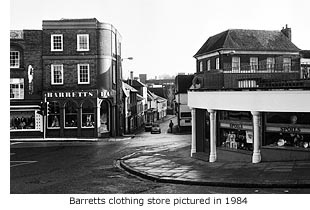 As with the grocery business when it changed hands, the clothing store also kept the familiar name of Holland & Barrett above the door. In the late 1930s Wilfred Marshall's son, Raymond, joined the business, as did Harry Marshall's son, Bernard, in 1942. With little competition the shop prospered, changing its name in the early 1970s to just 'Barretts'. But as more and more new clothing stores opened in the town during the 1980s, their traditional and somewhat old fashioned approach in a modern retail market eventually affected trade. This, combined with disinterest by younger members of the Marshall family to continue running the business led to Managing Director Peter Marshall (Raymond's son) closing the shop for good in 1999. The property was then sold to a popular restaurant chain that now occupies the larger of the two buildings. Although nothing remains of the original shop interior, the red-brick frontage and wrought ironwork at roof level was left untouched. Large decorative urns that once graced the roof parapet in the early 1900s disappeared long ago. As with the grocery business when it changed hands, the clothing store also kept the familiar name of Holland & Barrett above the door. In the late 1930s Wilfred Marshall's son, Raymond, joined the business, as did Harry Marshall's son, Bernard, in 1942. With little competition the shop prospered, changing its name in the early 1970s to just 'Barretts'. But as more and more new clothing stores opened in the town during the 1980s, their traditional and somewhat old fashioned approach in a modern retail market eventually affected trade. This, combined with disinterest by younger members of the Marshall family to continue running the business led to Managing Director Peter Marshall (Raymond's son) closing the shop for good in 1999. The property was then sold to a popular restaurant chain that now occupies the larger of the two buildings. Although nothing remains of the original shop interior, the red-brick frontage and wrought ironwork at roof level was left untouched. Large decorative urns that once graced the roof parapet in the early 1900s disappeared long ago.
Thanks to Bernard Marshall for added information about his family's ownership of the store.
Alfred Slapps Barrett
Alfred Slapps Barrett was of Irish descent, his grandfather Simon Barrett coming from County Cork and settling in Cambridge where he founded a successful glass and china business. Of the fourteen children fathered by his son Robert, Alfred Slapps was born 14 May 1850 at Market Hill, Cambridge, close to King's College Chapel. How the name 'Slapps' originated remains a mystery. As a young man his intention was to go to South Africa, but when in 1870 the opportunity arose to go into business with Major William Holland (1846–1915), he took it.
Alfred's wife, Eliza Ann, was the only daughter of *Mr and Mrs Charles Dodd, Mr Dodd being a partner in the North Street grocery and clothing store Dodd & Burls before it was sold to William Holland and Alfred to become Holland & Barrett. Living at Chantry Villa (See Guide 5 – Half Acres) Alfred and Eliza Ann had ten children – three girls and seven boys – the eldest son, Alfred, being killed in action in France while serving with the Canadian Field Artillery. Of their daughters, Eva became a photographer and lived in Rome, and Elsie May later became the first woman Chairman of the local Urban District Council.
To those who didn't know him very well, Alfred was a rather brusque man. He didn't suffer fools gladly, had no patience with inefficiency and was a stipler for punctuality. But beneath this somewhat fearsome exterior his true character was one of caring and benevolence. He was a staunch supporter of Temperance (See Guide 15 – The Temperance Movement) and a robust nonconformist, attending the Congregational church in Water Lane where for twenty years he was a member of the quoir. He chose the site of the Institute in Water Lane (now the Congregational Church Hall) and helped raise around £3,000 to purchase the land on which it was built in 1914/15. He also raised a substantial amount of money to buy and renovate the Manse that stood opposite the church (See Guide 5 – The Manse) and to enlarge Northgate School (See Guide 7 – Northgate School).
From the late 1800s he also held the town’s only pawnbroker's licence, bought from the previous owner of it, Mr Marsh at 21 North Street, when he retired from business. Alfred was totally opposed to people pledging their possessions and it is for this reason that since that time no pawnbroker has operated in Bishop’s Stortford. (In 1846 the pawnbroker licence was owned by watch and clockmaker James Yardley, who traded at High Street.)
Alfred Slapps Barrett was a pillar of the local community, always willing to help and associated with most organisations in the town. He was Director of Bishop's Stortford Gas & Electricity Company until it became a subsidery of the Northmet Electricity Company, a member of the Burial Board and a member of the town fire brigade, eventually becoming Chief Officer. Along with Edgar Carruthers (See Guide 5 – Hadham Road) and others he formed the Town Brotherhood, and was vice president of the National Brotherhood Movement.
Locally, observance of Armistice Day (November 11) was inaugurated by him and carried out at his own expense until taken over by the council in the late 1920s. And his appreciation of music was reflected in the fact that he was associated with every town band from the 1890s onwards.
In January 1933 his wife Eliza Ann died at their home (Chantry Villa), aged 77, and in June that same year Albert also died there, aged 83. Although suffering from an illness for some time, it is said he never recovered from the loss of his wife and that his death was more likely to have been caused by a broken-heart. His funeral service took place at the (then) Congregational church in Water Lane, where a small memorial is dedicated to him.
Their grave at New Cemetery also commemorates five of their children: Alfred (1877–1918), Elsie May (1888–1947), Margaret Louise (1882–1961), Gilbert (1886–1965), and Una Christabel *1893–1976).
His name also lives on in the town. Dodd's Lane was named after Mr Dodd's, whose grocery store stood at the corner of the lane, but was renamed Barrett Lane after Alfred's death. The name Holland & Barrett also survives into the 21st century as a successful, albeit unrelated, trading name of a large chain of Health shops, one of which is situated in South Street (See Guide 15 – Holland & Barrett).
*An 1823 local trade directory lists James Dodd's name at North Street, under 'Grocers & Tea Dealers'. He also appears in the 1828/29 and 1839 directory, though in the latter he is described as 'Grocer & Draper'. In 1846 this changes to 'Grocer & Clothier' under the name of Mrs Ann Dodd, the business seemingly changing hands within the family. When Charles Dodd took over the business is unknown, nor is it known when the partnership of Dodd & Burls was formed. And if that wasn't particularly helpful, I've also yet to find out where their original shop was sited in North Street, and when Dodd & Burls took over Summers printshop (No 22), which later became Holland & Barrett. MORE PICTURES
|
|
|
|
No10: Herts & Essex Observer
|
|
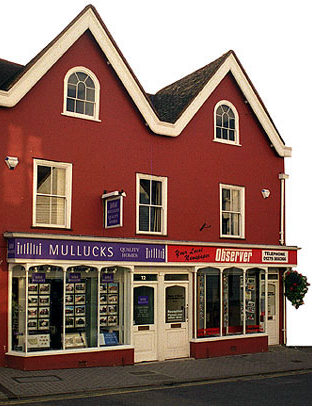 This building is thought to have been constructed around 1550, although first mention of it wasn't until 1656 when glazier William Bennett sold the property to a butcher named John Clark. Whether or not it was he who altered the building to the unusual but distinctive structure it is today is unknown, but around that time it was heightened by the addition of two gables, front and back. This building is thought to have been constructed around 1550, although first mention of it wasn't until 1656 when glazier William Bennett sold the property to a butcher named John Clark. Whether or not it was he who altered the building to the unusual but distinctive structure it is today is unknown, but around that time it was heightened by the addition of two gables, front and back.
In 1724 it was in the ownership of Edward Auvergne who leased it to Messrs Rose & Sadler, and remained in Auvergne ownership until Edward's son, Philip, sold it to Trevor Robinson, a salesman, and Thomas Adderley, landlord of the Crown Inn at Hockerill. William Francis sold it to William Alger in 1806 and a few years later it apparently housed a printing business owned by Thomas Bradfield, bookseller and printer. He was also the town postmaster from 1841–1858. Strangely, the Hertfordshire Almanac notes that Alfred Ellis filled the position of postmaster from 1858–1860 and yet no trace of this appointment can be found in Post Office Minutes. What is recorded, though, is that Thomas Belsey May became postmaster in 1860.
His name also appears in Peter A Forrestier Smith's book Bishop’s Stortford, An Outline Postal History, in which he writes that Mr May founded and first published (6 April 1861) the Bishop’s Stortford Observer in this building after acquiring the property from Thomas Bradfield. This fact, however, is disputed by renowned local historian Wally Wright, who says the newspaper was started by a Henry Collins and first went into print at Bridge Street. He also says the paper didn't move to these premises until 1863.
There is little reason to doubt the trusted knowledge of Mr Wright, because certain events relating to the 'actual' date of Thomas Belsey May's ownership of the newspaper do warrant further investigation – as do the whereabouts of Thomas Bradfield's and Mr Collins' respective printing businesses. Significantly though, an editorial feature about the history of the newspaper that appeared in the Hert & Essex Observer dated 12 July 1963, states that it was first published by Thomas Belsey May and was then owned by Henry Collins.
Without more detailed research, no positive conclusions can yet be drawn but the following should also be noted:
1) Henry Collins & Co, printers, booksellers & stationers, traded in North Street from 1859 until 1870, then moved to premises 'close to the Corn Exchange'.
2) Although Thomas Bradfield is said to have owned these premises (No 10) from the early 1800s, an 1839 trade directory makes no mention of him being in North Street but does list him at Bridge Street as bookseller, stationer & printer. In 1846 he is again listed at Bridge Street, this time as printer, bookseller & binder, stationer & circulating library, postmaster, and agent for Clerical Life. The only printer recorded in North Street at that time was *John Morse Mullinger.
3) In 1863 Thomas Belsey May was severely censured by the postal authorities for owning and editing a newspaper while employed as town postmaster. But if Mr May had been postmaster since 1860 and supposedly established his newspaper in April 1861, why did it take the postal authorities until 1863 to find out about his ownership of the paper?
Putting these contentious points aside: in May 1863, on learning of Mr May's dual role as postmaster and newspaper proprietor, the postal authorities insisted he effect a bona fide sale of the paper within three months. To placate the authorities Mr May then made a fictitious sale, but when his deception was discovered he incurred the full wrath of the Postmaster General. Terming the whole affair as a 'discreditable matter', he said that Mr May would be dismissed if his performance as postmaster didn't improve. Not surprisingly the position of postmaster became vacant in November that same year.
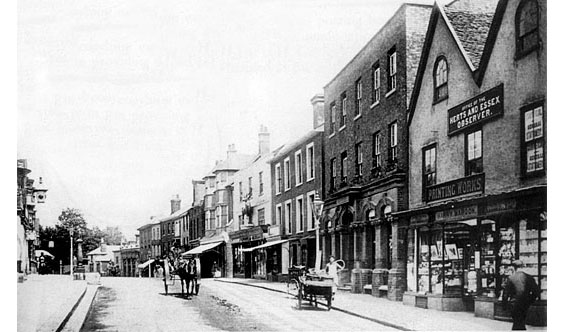
In 1862 the Bishop’s Stortford Observer (be it in the ownership of Mr May or Mr Collins) changed its name to the Herts & Essex Observer, and in June the following year swallowed up rival newspaper the Bishop’s Stortford Gazette barely two months after its launch. In 1888 The Herts & Essex Observer was acquired by the Mardon brothers, who the following year faced competition from another new paper the Bishop’s Stortford Weekly News. In the event, this proved no threat and within four months merged with the Saffron Walden Weekly News.
The Herts & Essex Observer continued to be printed on presses in this building’s basement until 1961, at which time it was taken over by Stephen Austin Newspapers – Hertford's first printing firm founded in 1768 by Stephen Austin, owners of the Hertfordshire Mercury.
Since its beginnings in 1861 (or 1863) the newspaper's staff had always occupied offices on both sides of this double-fronted building. But by the mid 1980s it was in serious need of renovation. Staff were moved to temporary offices across the street in White Horse Court, and on their return in 1991 the ground floor was shared with estate agent Mullucks Wells. MORE PICTURES
*In 1826, John Morse Mullinger printed at his North Street premises (See No 16 – Boardmans) a second edition of Henry Chauncy's 'Historical Antiquities of Hertfordshire (See Guide 3 – Henry Chauncy. Mullinger is also recorded at North Street in 1846 as printer, bookseller & binder, stationer & subdistributer of stamps. In 1825 he was a witness at the trial of Thomas Rees (See Guide 1 – Threat to burn down the town of Bishop's Stortford).
*In 1864 a former teacher, George Manville Fenn (1831–1909), a failed small magazine owner from Lincolnshire, became 'part proprietor' of the Herts & Essex Observer – probably with Thomas Belsey May. For whatever reason the business venture was short-lived, but that same year Fenn sruck gold when he had a short sketch entitled In Jeopardy accepted by Charles Dickens for his own weekly journal All the Year Round. The rocognition this brought him as a novelist led to countless published stories in a wide variety of magazines and newpapers and more than 170 separate books.
|
|
|
|
No14: Boardmans
|
|
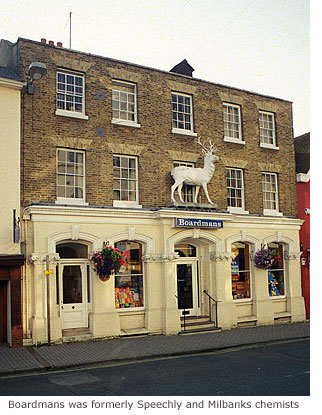 This magnificent double-fronted building, originally built as a private house, stands on the former site of the Falcon public house, itself demolished in the 1750s as a result of a local road-widening scheme. Boardmans took over the shop in 1982, but since the early 1800s the premises had been a chemists, first occupied by Speechley and Milbank and latterly by Kingswood's. This magnificent double-fronted building, originally built as a private house, stands on the former site of the Falcon public house, itself demolished in the 1750s as a result of a local road-widening scheme. Boardmans took over the shop in 1982, but since the early 1800s the premises had been a chemists, first occupied by Speechley and Milbank and latterly by Kingswood's.
The stone carvings mounted on the brick pillars supporting the shop’s large window frames are all representations of various herbs used in medicine. These date from 1885 when the building was being restored, each carving created on the pavement outside the shop by Italian workmen, primarily engaged to add mosaics to the altar of St Michael’s church. Wrought iron railings were a feature of the shop’s windowsills up until 1914, at which time they were taken down for salvage to aid the war effort.
A regular town event at the turn of the 20th century was the parade of work horses in Causeway, after which they were brought to North Street for judging and sale by auction. The worn stone steps at the shop’s entrance were the auctioneer's platform. Sir Walter Gilbey, when he lived at Elsenham (See Guide 2), would often bring part of his harvest of peppermint and lavender to Speechly & Milbank's for distilling, the fragrant end product later used as gifts for his family and friends.
 Prominent above the shop’s entrance stands the original *White Hart emblem of the 1st Herts Light Horse regiment, especially made in 1862 for the regiment’s barracks at Silver Leys (See Guide 5 – Silver Leys). When the regiment disbanded in 1868, Major William Holland rescued the stag and later mounted it on the fascia above his grocery shop at the corner of Barrett Lane. And there it stood until 1983 when the grocery store was demolished and replaced by the present building, owned by HSBC. The bank paid for restoration of the 'weathered' stag that took three years to complete, and on its return in 1986 was placed above Boardman’s entrance. Prominent above the shop’s entrance stands the original *White Hart emblem of the 1st Herts Light Horse regiment, especially made in 1862 for the regiment’s barracks at Silver Leys (See Guide 5 – Silver Leys). When the regiment disbanded in 1868, Major William Holland rescued the stag and later mounted it on the fascia above his grocery shop at the corner of Barrett Lane. And there it stood until 1983 when the grocery store was demolished and replaced by the present building, owned by HSBC. The bank paid for restoration of the 'weathered' stag that took three years to complete, and on its return in 1986 was placed above Boardman’s entrance.
*A White Hart is the symbol of the county of Hertfordshire.
Speechly & Milbank
The original chemist shop was owned by George Speechly, born c.1833 in Peterborough, Northamptonshire. Where and when he obtained his pharmacy credentials is unknown, as is the year he became a chemist in Stortford, but in 1883 he took on an apprentice named Sydney Thomas Milbank.
Sydney was born c.1866 at Little Waltham, Essex (a few miles north of Chelmsford). After serving his apprenticeship with George Speechly he went to London to qualify and then became an assistant at Coopers (said 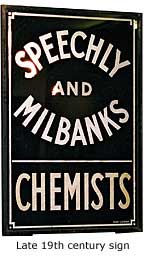 to have been the first Oxford Street shop to have electric light). He returned to Bishop's Stortford a few years later to assist George Speechly, eventually taking over the business in 1892 when Speechly retired, and in 1915 was joined in partnership by his son, Sydney Alexandra (b. c.1894). to have been the first Oxford Street shop to have electric light). He returned to Bishop's Stortford a few years later to assist George Speechly, eventually taking over the business in 1892 when Speechly retired, and in 1915 was joined in partnership by his son, Sydney Alexandra (b. c.1894).
A pillar of the local community, he was chairman of the old Hertfordshire Pharmaceutical Committee for more than 25 years and a prominent Freemason, being Master of St Michael's Lodge, Bishop's Stortford. He was also founder and past Master and Treasurer of Harlow Lodge; provincial Grand Warden of the Province of Hertfordshire in 1930; and held provincial rank in the province of Essex. He was life governor of the Royal Masonic Girls' Institution; the Royal Masonic Boys' Institution, and the Royal Masonic Benevolent Institution.
Sydney was also a member of Bishop's Stortford Bowls Club since its formation in 1905, and president for 20 years; chairman of the Bishop's Stortford Market Company, which administered the Corn Exchange; and for many years chaiman of Bishop's Stortford Friendly Society. His principle hobby was to tend an 'old-world' garden at the rear of his North Street premises but he was also interested in boating, owning a house boat and a sailing boat at Oulton Broad where he spent most of his holidays.
His wife died in 1928 and his daughter, Eleanor, in 1948. Sydney never actually retired from the chemist shop but after suffering a long illness he died 17 April 1952, aged 86 years. In reporting his death the Herts & Essex Observer referred to him as Bishop's Stortford's oldest tradesman.
The business was continued by his son Sydney Alexandra, who himself died 4 April 1973, aged 79. His wife Mary (Edyth Mary) died 26 January 1994, aged 92. MORE PICTURES
|
|
|
|
No16: Boardmans
|
|
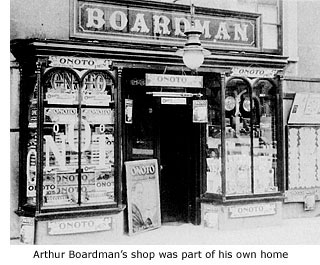 In 1823 this was a double-fronted house with bay windows from which John Morse Mullinger ran his printing business. It is also where, in 1826, Mullinger printed the second edition of Henry Chauncy's The Historical Antiquities of Hertfordshire (See Guide 2 – Henry Chauncy). A tenant at that time, he bought the property in 1850 from Mary Lord of Sawbridgeworth. It then passed to his son, James Bass Mullinger, and in 1864 the tenant was Arthur Boardman, the founder of Boadmans. In 1823 this was a double-fronted house with bay windows from which John Morse Mullinger ran his printing business. It is also where, in 1826, Mullinger printed the second edition of Henry Chauncy's The Historical Antiquities of Hertfordshire (See Guide 2 – Henry Chauncy). A tenant at that time, he bought the property in 1850 from Mary Lord of Sawbridgeworth. It then passed to his son, James Bass Mullinger, and in 1864 the tenant was Arthur Boardman, the founder of Boadmans.
Arthur Boardman was a well-respected figure in Stortford and a man of many parts. He supported lectures at the Corn Exchange, promoted literacy in the town by arranging essay and poetry competitions, and put his considerable talent as an artist to good use by drawing political cartoons.
He was also Honourary Secretary of the Literary Guild and of the Bishop’s Stortford Subscription library (1872 and 1878), the latter, apparently, being housed in these premises from 1827–1927. Whether or not the library was instigated by John Morse Mullinger or by the property owner at that time, Mary Lord, is unknown but Arthur Boardman would have had no difficulty in carrying on with it. In fact, it was his love of literature that eventually led him to convert part of his home into a bookshop. When he finally bought the property in 1900 he expanded the bookshop to the whole of the ground floor and lived in the rooms above.
When Arthur died in 1915 he was succeeded by his son, Herbert Charles, who later became a senior partner in the firm. The other partner was Mr S. J. Rickard. When bachelor Herbert died 16 November 1940, aged 69, the business passed the following year to Mr Rickard and then to his daughter, Kathleen, who married John Hampton. Their son, Charles, currently owns and runs the business. MORE PICTURES
|
|
|
|
|
|
|
|
|
|
|
|
|
|




 As with the grocery business when it changed hands, the clothing store also kept the familiar name of Holland & Barrett above the door. In the late 1930s Wilfred Marshall's son, Raymond, joined the business, as did Harry Marshall's son, Bernard, in 1942. With little competition the shop prospered, changing its name in the early 1970s to just 'Barretts'. But as more and more new clothing stores opened in the town during the 1980s, their traditional and somewhat old fashioned approach in a modern retail market eventually affected trade. This, combined with disinterest by younger members of the Marshall family to continue running the business led to Managing Director Peter Marshall (Raymond's son) closing the shop for good in 1999. The property was then sold to a popular restaurant chain that now occupies the larger of the two buildings. Although nothing remains of the original shop interior, the red-brick frontage and wrought ironwork at roof level was left untouched. Large decorative urns that once graced the roof parapet in the early 1900s disappeared long ago.
As with the grocery business when it changed hands, the clothing store also kept the familiar name of Holland & Barrett above the door. In the late 1930s Wilfred Marshall's son, Raymond, joined the business, as did Harry Marshall's son, Bernard, in 1942. With little competition the shop prospered, changing its name in the early 1970s to just 'Barretts'. But as more and more new clothing stores opened in the town during the 1980s, their traditional and somewhat old fashioned approach in a modern retail market eventually affected trade. This, combined with disinterest by younger members of the Marshall family to continue running the business led to Managing Director Peter Marshall (Raymond's son) closing the shop for good in 1999. The property was then sold to a popular restaurant chain that now occupies the larger of the two buildings. Although nothing remains of the original shop interior, the red-brick frontage and wrought ironwork at roof level was left untouched. Large decorative urns that once graced the roof parapet in the early 1900s disappeared long ago. This building is thought to have been constructed around 1550, although first mention of it wasn't until 1656 when glazier William Bennett sold the property to a butcher named John Clark. Whether or not it was he who altered the building to the unusual but distinctive structure it is today is unknown, but around that time it was heightened by the addition of two gables, front and back.
This building is thought to have been constructed around 1550, although first mention of it wasn't until 1656 when glazier William Bennett sold the property to a butcher named John Clark. Whether or not it was he who altered the building to the unusual but distinctive structure it is today is unknown, but around that time it was heightened by the addition of two gables, front and back.
 This magnificent double-fronted building, originally built as a private house, stands on the former site of the Falcon public house, itself demolished in the 1750s as a result of a local road-widening scheme. Boardmans took over the shop in 1982, but since the early 1800s the premises had been a chemists, first occupied by Speechley and Milbank and latterly by Kingswood's.
This magnificent double-fronted building, originally built as a private house, stands on the former site of the Falcon public house, itself demolished in the 1750s as a result of a local road-widening scheme. Boardmans took over the shop in 1982, but since the early 1800s the premises had been a chemists, first occupied by Speechley and Milbank and latterly by Kingswood's. Prominent above the shop’s entrance stands the original *White Hart emblem of the 1st Herts Light Horse regiment, especially made in 1862 for the regiment’s barracks at Silver Leys (See Guide 5 – Silver Leys). When the regiment disbanded in 1868, Major William Holland rescued the stag and later mounted it on the fascia above his grocery shop at the corner of Barrett Lane. And there it stood until 1983 when the grocery store was demolished and replaced by the present building, owned by HSBC. The bank paid for restoration of the 'weathered' stag that took three years to complete, and on its return in 1986 was placed above Boardman’s entrance.
Prominent above the shop’s entrance stands the original *White Hart emblem of the 1st Herts Light Horse regiment, especially made in 1862 for the regiment’s barracks at Silver Leys (See Guide 5 – Silver Leys). When the regiment disbanded in 1868, Major William Holland rescued the stag and later mounted it on the fascia above his grocery shop at the corner of Barrett Lane. And there it stood until 1983 when the grocery store was demolished and replaced by the present building, owned by HSBC. The bank paid for restoration of the 'weathered' stag that took three years to complete, and on its return in 1986 was placed above Boardman’s entrance.